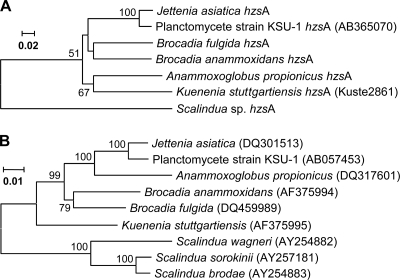Fig 1.
(A) Phylogenetic analysis of hzsA gene sequences from established species of anammox bacteria used to design primers. The evolutionary history was inferred using the neighbor-joining method. The bootstrap consensus tree inferred from 500 replicates is taken to represent the evolutionary history of the taxa analyzed. Branches corresponding to partitions reproduced in less than 50% bootstrap replicates are collapsed. The percentages of replicate trees in which the associated taxa clustered together in the bootstrap test (500 replicates) are shown next to the branches. The tree is drawn to scale, with branch lengths in the same units as those of the evolutionary distances used to infer the phylogenetic tree. The evolutionary distances were computed using the Jukes-Cantor method and are shown as numbers of base substitutions per site. Codon positions included were first plus second plus third. All ambiguous positions were removed for each sequence pair. There were a total of 2,433 positions in the final data set. (B) For comparison, a 16S rRNA gene-based phylogenetic tree is shown (derived from reference 38).

